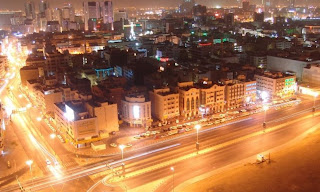 Now that Earth Hour has come and gone, and seen lukewarm participation by city-zens in this country, it is time for some introspection. Yes, we were not official party to the event but what prevented organizations like Bescom from switching off street lights for an hour? When load shedding is still being done, why not use the time to show solidarity with a global campaign?
Now that Earth Hour has come and gone, and seen lukewarm participation by city-zens in this country, it is time for some introspection. Yes, we were not official party to the event but what prevented organizations like Bescom from switching off street lights for an hour? When load shedding is still being done, why not use the time to show solidarity with a global campaign?Why street lights? Simply because they are used in most places most inefficiently. Most major cities, (like Dubai in the above picture) literally flood the streets with lights. Often there is no design or scientific study that goes into the system.
Street lights are termed as the biggest energy guzzlers in municipalities, using much higher wattage than mandated.
Do we need those glowing sodium vapour lamps everywhere? Or tube lights better? How about solar lighting?
There is much that can be done to save energy and costs and improve lighting on the streets. As shown by Vadodara Municipal Corporation that implemented Energy Conservation measures in Street Light Service and was recently awarded the national energy conservation award, 2008.
Some of the energy efficiency measures it adopted were no-cost measures and includes conversion of T12 FTL into T8 FTL, procurement of low watt loss ballast, conversion of HPMV into HPSV (Lamp selection based on lumen efficacy), design based lighting, time management, staggering/dimming of street lighting during off peak hours, installation of microprocessor Based Intelligent Street Light Controller with GSM technology for data transfer, etc.
For the last 5-6 years, around 7 lakh kilowatt hours have been saved every year, and in terms of money saved, around Rs 28 lakhs every year.
Adoption of these practices has meant reduction in maintenance cost, low lifecycle cost, besides environmental protection.
The service of energy auditors could be employed for these activities. Any reason for not implementing any of the above measures?



2 comments:
Greetings!
I have read with interest your blog on huge wastage of energy by technologically incorrect use of lamps for street lighting.
There is yet another aspect - that of light pollution - which is catching the attention of environmentalists. I have copy-pasted below a report that appeared in CONSUMER WATCH.
Regards,
S. Gopal
--
CONSUMER WATCH
Regulate light-polluting commercial hoardings
One annoying but rarely discussed consequence of large hoardings that line the cityscape happens to be light pollution. Whether the hazy illumination distracts motorists or not is debatable, but residents who live near flyovers, highways and arterial roads, where many of these hoardings are placed, complain about their disturbing glow.
Now, Ahmedabad's Consumer Education and Research Centre (CERC) intends to launch a campaign to regulate the city's hoarding light timings by roping in the Ahmedabad Municipal Corporation. Mumbai already has a 11 pm deadline for switching off hoarding lights.
Vinod Sampat, president at Mumbai's Cooperative Societies' Residents and Users Association, says the glow may not be felt by residents of the host building, considering a hoarding is usually perched on the terrace, but it is a nuisance to those living in neighbouring structures.
Very good & informative blog. Thanks for quoting Vadodara case study. I am the person who has implemented energy efficiency initiatives in Vadodara City. in street light service at least 50% energy saving is possible, even more in case of Dubai and over illuminated city. Over illumination is also generating light pollution over and above wastage of energy.
I will be glad to offer my services for improving Energy Efficiency in Municipal Utilities.
Post a Comment